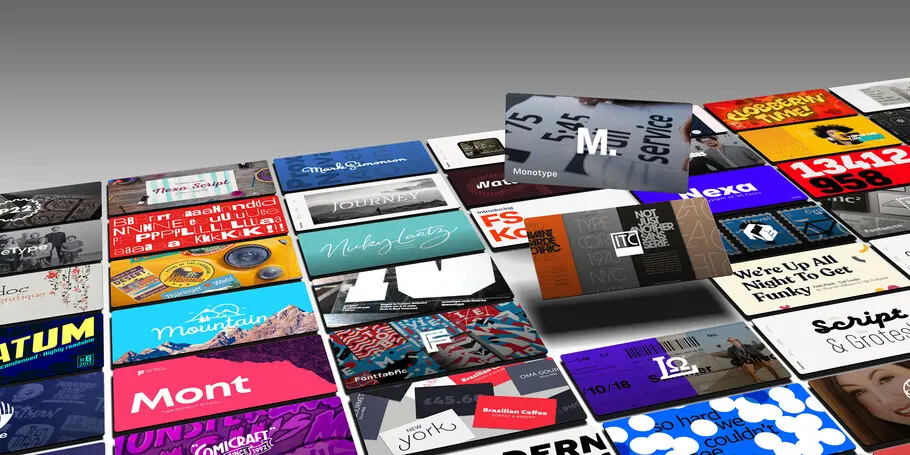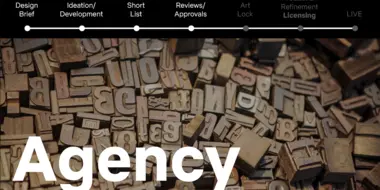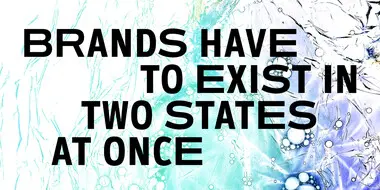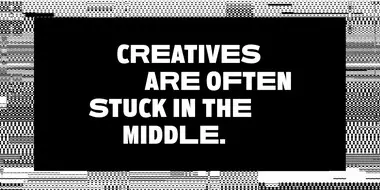5 tips for building a better font licensing strategy.

Kevin Laurino.
For brands that haven’t exactly been vigilant about their font licensing—that don’t have a good internal system and process for purchasing, updating, and sharing fonts—sorting out a sprawling font library can seem like a monumental task. It’s like venturing into your garage or attic after years of mindlessly shoving box after box into the space. Who knows what lurks in the darker, cobwebby corners? How do you even begin to organize it?
While it can seem overwhelming, the solutions are simpler than you might think. Kevin Laurino, Manager of Art & Print Production, Retouching, and Finishing at Netflix, shares some experiences from his career-long relationship with fonts and how to tame the beast that is managing a brand’s font licensing. Here are his tips to help get you started.
1. Understand the basics.
Most of the time, improper font usage is simply an accident due to a genuine lack of understanding about how licenses work. But intentional or not, using a font without obtaining a license or in a way that is impermissible with the existing license is highly problematic. Intellectual property (IP) protections are put in place for a reason, and they need to be understood and navigated appropriately, with proper licenses secured. Without those end-user licenses in place, any use of the IP is essentially stealing from the artist.
“Nobody talks about font licensing until it’s too late,” Laurino says. “There’s a tendency to say, ‘Look, I spent the 30 bucks, I licensed this font. What’s the big problem?’ And there’s just so much more to it.”
Avoiding these headaches can be as simple as educating yourself and your team on the importance and nuances of font licensing. Even after a brand has secured font licensing, the license should be closely managed. Your rights and types of usage can expire, and if that happens, any brand assets using that font might have to be taken down since there is no valid end-user agreement in place.
“My goal is to arm people with enough information not only for them to understand, but to help the people around them understand,” Laurino says. “People might be expert marketers, but they might not be familiar with the nuances of font licensing. So, it’s all about setting them up with enough information to make an educated decision.”
Kevin Laurino.
2. Assess the fonts you have.
Once you’ve educated yourself on some basics, it’s time to start looking at what you already have in place.
The easiest way to do this is to follow the asset’s chain of ownership, which can be a major vulnerability for brands. There will be times when the person who licensed the asset leaves the company, and with them goes any recollection of what was licensed, why, and for how long. If this is the case and you can’t validate an existing font, the best solution is to replace the font with something similar that has the proper end-user license.
“If I can’t figure out who sent me this font, I ask myself, ‘What do I need to do from this point forward to make sure I’m protected and my company’s protected?’” Laurino says. “A lot of times that means swapping in a font I can validate, where I can actually say, ‘Here’s my documentation; here’s why we can use this. Sorry, the “E” and maybe the “S” look a little different, but we just have to live with that.’”
When it comes to securing the fonts you have, it’s often a question of scale. Working through a few hundred fonts is manageable, but when you’re dealing with ten- or twenty-thousand fonts, the task can feel overwhelming and time-consuming. In these cases, approaching the task one project at a time can be the way to go. This helps maintain a balance between protecting yourself and your brand and actually getting work done.
One last note: This process can be difficult and full of dead ends. Determining whether a font is available for commercial work can be especially difficult when you’re working with free fonts. Laurino stresses the importance of honest and upfront communication with the people around you and never shying away from seeking the information you need. This could mean connecting with people that have the knowledge to complement your own or reaching out to the designer/font owner to clarify the license. Digging in to find this information may not be easy, but it’s essential to keep you from tripping your way into legal headaches.
Kevin Laurino.
3. Hedge your risk.
In addition to securing the fonts you are already using, it’s important to start getting ahead of any potential misuse before it happens. The best way to do this is to get all project stakeholders aligned as early as possible, preferably at the briefing stage, so you can help guide the teams toward fonts that are already licensed and/or help secure new licensing as needed. This will hedge the risk of improper font usage to reduce your brand’s financial and legal exposure.
But it doesn’t always work that way. And when you encounter a project using fonts with unclear rights, the conversations about swapping those fonts for something more secure can be tricky. “Everything is relationship management and expectation management,” Laurino says. “I spend a lot of time trying to understand other people’s perspectives so I can come to a solution that works for them.”
For Laurino, having ready-to-go alternatives to “risky” fonts is crucial. The creative team is invested in their art, and it can be challenging to convince them to change it, even when it is legally required. But if a team is using a font they shouldn’t be, they could end up changing the work anyway, and under less-than-ideal circumstances.
“It becomes a sales pitch,” Laurino says. “Basically, I’m saying, ‘Hey, I know you worked hard on this. And I know you had late-night calls with the filmmaker noodling on details of this art. But I have to tell you, this font opens us up to risk. So, I’m suggesting we swap it to this. Oh, and I also found ten more options that could work.”
Kevin Laurino.
4. Take the guesswork out of it.
OK, let’s say you find some right rhythm on a project-to-project basis. That’s great, but is it sustainable to manage font usage that way?
“‘Process’ can be a dirty word in some circles,” Laurino says, “but the reality is that to produce something, you just need some processes in place. The trick is to walk the line between creating an empowering design culture while implementing processes that keep risk to a minimum.”
It’s true that “process” triggers the occasional gag reflex. But perhaps “structure” is a better word, anyhow. A thoughtful, structure process should feel invisible. It supports the work and the people doing the work without getting in the way, allowing projects to flow from step to step without getting stuck. So, how do you structure a system for your creative teams that mitigates risk without inhibiting your designers’ creativity? Or, as Laurino says, “How do you take out the guesswork so your teams are free to focus on other things?”
For many brands, this means establishing a defined library of fonts that are approved for use, much like a subscription to a stock image library. Your brand’s set of fonts could number in the dozens or the thousands, but either way, it creates a safe, secure space for your designers, saving everyone time and effort. Whether the brand uses a font library like Monotype Fonts or its own collection of licensed fonts, the creative team is free to design whatever they want—within that specific set of fonts.
Not only does this mitigate risk, but having a secure library of available fonts means your creative teams aren’t spending hours investigating the rights associated with a particular font. A thoughtful set-up library will include fonts that are cleared (and clearly labeled) for specific uses.
“If you can shave off three steps in a ten-step process for every piece of art, across every title, across every vertical, across the world, you’re going to get people’s attention,” Laurino says.
5. Partner up.
Most people avoid working with legal because they don’t want to hear the word “No.” Better to ask forgiveness than permission, as the saying goes.
Not when it comes to fonts. Laurino emphasizes that working with legal is “not about policing; it’s about partnership. Bring in your legal expert early to make sure you’re within the realm of usable IP. The last thing you want is for somebody to fall in love with something that you can’t actually use in public.”
It’s not just legal either. Laurino recommends partnering with key stakeholders across the organization to minimize the possibility of a last-minute snafu. This goes for all the experts in your organization: AV, print, digital, physical production, anyone who can steer you clear of challenges ahead of time. Partner up with people that might tell you something you don’t want to hear! It’s better to get that upfront before you’ve invested time and people’s salaries in projects.
“I think you have to acknowledge that these conversations can and sometimes will be uncomfortable,” Laurino says. “I’m not saying this is easy, but it’s worthwhile. And the reality is you’re all working toward the same goal, which is to do great work and keep your brand or your clients protected.”
Kevin Laurino.
So, to summarize:
- Proper font licensing is essential to protect your brand from both financial and legal liability. Addressing font licensing during the design planning phase of any project can save headaches, time, money, and heartache.
- When a licensing issue does arise, work to educate everyone on why the font cannot be used and offer a solution of similar fonts that can be swapped.
- Proactively hedging risk by using a font library helps you get clear, secure art while giving your creative team the freedom they desire within a specific group of fonts.
- Legal is your partner, not the police! Get the green light for a font to be used in the public domain before presenting it. Partner up with experts across your organization.
- You have a responsibility to do what is best for the brand. Don’t be afraid to speak up and educate yourself so you can make the best decision. Always be ready to ask questions and seek out the information if you don’t know.
The takeaway: Don’t put your head in the sand.
Let’s say you find a dubious font being used in a project. You might be tempted to tell yourself that no one will ever notice. Who pays that close attention, anyway? And maybe in some cases, no one will notice. Right?
“Sometimes you see [a font], and you just kind of know it’s probably not on the up-and-up when it comes to using it for commercial work or paid marketing work,” Laurino says. “Don’t put your head in the sand. It doesn’t really matter how many people are going to see it. These intellectual property protections are in place for a reason. The number one issue when it comes to any kind of IP stuff is, don’t assume people won’t find out.”
More broadly, Laurino says people shouldn’t shy away from educating themselves on what can appear to be a complicated topic. Font licensing isn’t actually very complex, but the jargon and certainly the stakes of getting it wrong can feel intimidating—especially if you find yourself on the spot to approve or perhaps investigate a font, with the project deliverables and deadlines hanging in the balance.
“One thing I’ve learned recently is that it’s okay to not have the answer right away,” Laurino says. “It’s okay to share that you’re at the edge of your knowledge about this and that you need to learn more to make the right decision.
“I’ve developed a working knowledge of fonts and what’s involved. But if I want a deeper understanding, and if people start coming to me like I’m our resident ‘expert’ on the subject, I’m never going to get there if I’m just faking it. It’s okay to be vulnerable! It doesn’t mean you’re bad at your job. It actually means you’re at a point now where you’re going to grow. So, go seek out the people who have the knowledge to complement your own.”
Jessica Saxena is a freelance writer who is passionate about the intersection of business and design. When she’s not writing, you’ll likely find her lost in a book or out exploring the world around her.














